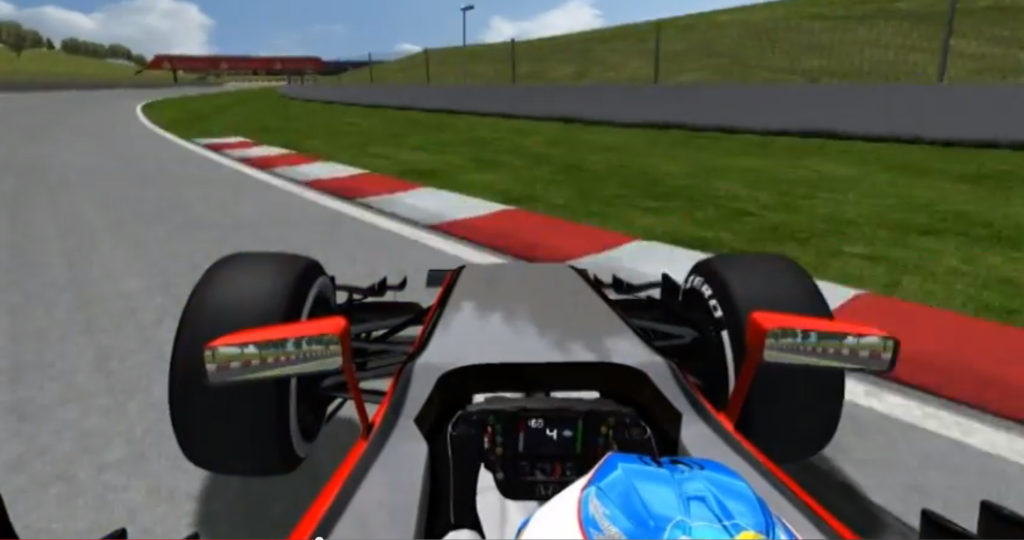Als ich gestern das Statement von McLaren zum Crash von Fernando Alonso las, rieb nicht nur ich mir verwundert die Augen. Kurz gefasst: ein heftiger Seitenwind sei Schuld gewesen am Testunfall von Fernando Alonso am Sonntag. Das hätten die Auswertungen der Telemetriedaten ergeben. Der spanische Doppelweltmeister hätte deshalb die Kontrolle über den McLaren-Honda verloren und wäre mit 30g seitlich in die Mauer geprallt. Damit war die Sache für die meisten meiner Kollegen erledigt. Sie folgten nahezu blind der Darstellung des McLaren-Teams.
„Kein Stromschlag! McLaren klärt Alonso-Unfall auf“ war die Überschrift bei „Motorsport-Total.com“. „Auto-Motor-und-Sport.de“ titelte: „Fahrer Schuld am Crash – kein Stromschlag“. Deshalb schon mal vorab eine provozierende Frage: Wenn McLaren behauptet hätte, dass Deutschland doch den Krieg gewonnen hat; wären die ehrenwerten Kollegen dieser These dann auch gefolgt? Ich jedenfalls habe immer noch meine Zweifel an dem windigen Statement.
Und nicht nur ich. Auch Formel-1-Insider in bedeutenden Positionen, mit denen ich mich unterhalten habe, finden die McLaren-Argumentation unglaubwürdig. Behaupten kann McLaren nämlich viel. Ich bin erst dann überzeugt, wenn unabhängige Experten die Telemetriedaten ausgewertet haben und die McLaren-Aussagen bestätigen. In einem Gerichtsfall wird ja auch nicht unbedingt ein Freispruch ausgesprochen, wenn Mann, Frau, Geliebter oder Geliebte für den Partner aussagen. Im Moment hat der Vorfall für mich noch den Status eines Indizienprozesses ohne gültigen Beweis. Als Staatsanwalt müsste man mir deshalb schlüssige Antworten auf folgende Fragen liefern:
- Wenn es der Wind war, der Alonsos McLaren auf die schiefe Bahn gebracht hat: Wieso war der wesentlich schneller fahrende Sebastian Vettel nicht davon betroffen? Vettel fuhr direkt hinter Alonso und wunderte sich, dass der McLaren allen physikalischen Gesetzen zum Trotz mit relativ niedriger Geschwindigkeit plötzlich nach rechts abbog. Als wäre Alonso nicht mehr Herr seiner Sinne gewesen. McLaren behauptet, der Spanier hätte noch zurückgeschaltet, gebremst und den Boliden trotzdem nicht mehr unter Kontrolle gebracht, weil zuerst der Grip weg war und dann plötzlich wieder da. Bei 150 km/h? Das wäre vermutlich noch nicht einmal dem führerscheinlosen Marco Reus passiert! Und ausgerechnet ein Alonso soll solche Anfängerfehler machen? Da habe nicht nur ich meine Zweifel. Zumal laut McLaren ein mechanisches Gebrechen des Autos nicht vorlag. McLaren führt an, dass auch andere Fahrer vom dem an diesem Tag heftigen Seitenwind betroffen waren. Der Abflug von Carlos Sainz junior an der gleichen Stelle wird als Beispiel dafür angeführt. Das wird von Toro Rosso und Red Bull auch bestätigt. Allerdings weist man in diesem Lager ausdrücklich darauf hin, dass Sainz mit erheblich grösserer Geschwindigkeit an dieser Stelle gefahren ist. Der Seitenwind, so bestätigten mir Formel-1-Texchnikexperten, hätte dagegen bei der von Alonso zum Zeitpunkt des Unfalls gefahrenen Geschwindigkeit keinen Einfluss auf das Fahrverhalten eines Formel-1-Wagens. Und sie weisen auch darauf hin, dass sich Sainz, als er die Kontrolle über den Toro Rosso verloren hat, in der schnellen Rechtskurve wie erwartet nach links gedreht hat. Und nicht nach rechts abgebogen ist wie Alonso.
McLaren say Alonso downshifting while applying full brakes in accident.Unusual to pull for downshifts if you’ve lost control of a racing car
— Martin Brundle (@MBrundleF1) 24. Februar 2015
- Warum hat Alonso eine Gehirnerschütterung erlitten? Was ist von den Fotografen und andere Augenzeugen zu halten, die bemerkt haben wollen, dass Alonsos Kopf schon vor dem Aufprall an die Mauer nach unten geknickt war, wie es typisch für einen Bewusstlosen ist? Der Aufprall von 30g war für Formel-1-Verhältnisse nicht aussergewöhnlich hart. Trotzdem trug der Spanier eine Gehirnerschütterung davon. Warum? Waren die extrem trainierten Halsmuskeln etwa nicht angespannt, weil er bewusstlos war? Ich habe schon an einem Sonntagabend in Montreal mit einem Heinz-Harald Frentzen zu Abend gegessen, der bei einem Unfall am Nachmittag mit einer diagnostizierten Gehirnerschütterung aus dem Medical-Center entlassen wurde. Selbst ein Robert Kubica konnte nach seinem Megacrash in Kanada am Montagmorgen wieder die Klinik verlassen. Und unser WM-Held Christoph Kramer verfolgte das WM-Endspiel gegen Argentinien nach seiner Auswechslung wegen einer schweren Gehirnerschütterung, benommen zwar, aber eben dennoch auf der Trainerbank. Alonso aber wurde mit dem Hubschrauber in eine Klinik geflogen, nachdem man ihn für den Flug sogar narkosiert hatte. Man hat ihn nicht am Montag mit seiner Gehirnerschütterung erlassen, sondern klemmte ihn an Geräte in der Intensivstation. Zur Beobachtung. Doch was wollte man beobachten? Ärzte bestätigten mir, dass es beispielsweise bei Stromopfern notwendig wäre, genau die Massnahmen zu ergreifen, welche die spanische Ärzte bei Alonso ergriffen – um lebensgefährlichem Herzkammerflimmern, das auch 24 Stunden nach einem solchen Vorfall noch auftreten kann, sofort bekämpfen zu können.
- Warum hat McLaren einen Tag gebraucht, um sein Statement zu verfassen? Mehrere Verantwortliche anderer Teams versicherten mir, dass die Art der Daten, die McLaren analysiert hat, noch am gleichen Abend hätten rausgehen können. Musste man sich erst mit den Honda-Chefs in Japan absprechen? Und mit einem Alonso, der erstmal wach werden musste? Um die wahre Unfallursache zu verschleiern? Einen Stromschlag durch ein defektes Energie-Rückgewinnungssystem etwa oder ein gesundheitliches Problem des Spaniers? Sind die besonders von FIA-Präsident Jean Todt geforderten mit Starkstrom-Batterien funktionierenden Hybrisysteme vielleicht doch nicht so sicher wie bisher versichert? Was passiert – sollte das der Fall sein – wenn das nächste Mal bei 300 Km/h ein Fahrer mitten im Pulk fahrend durch einen Stromschlag ausgeknockt wird? Ich weiß von mindestens zwei Fällen in letzter Saison, wo man Mechanikern gesagt hat, nur mit KERS-Handschuhen ans Auto zu treten, obwohl beim Auto das „grüne Entwarnungs-Licht“ leuchtete. FIA-Mitarbeiter jedenfalls verhielten sich am Sonntagabend äußerst merkwürdig. Man sollte doch froh sein, dass Honda wieder dabei wäre, war da zu hören. Die FIA sei ausserdem nicht für diesen Test zuständig. Warum zählte man aber dann mehrere FIA-LKWs in Barcelona? Was hatten die dort zu suchen?
Three CCTV cameras are watching and recording Turn 3 at Circuit de Barcelona-Catalunya. #F1 pic.twitter.com/Al3dFGCEH9 — f1talks.pl (@f1talks) 24. Februar 2015
There wasn’t any noticeable wind in Turn 3 according to Jordi Vidal. #F1 — f1talks.pl (@f1talks) 24. Februar 2015
Alle diese Fragen müssten in einem Indizienprozess erst noch schlüssig beantwortet werden. Von einem unabhängigen Expertenkonsortium aber bitte. Warum? Ich habe gelernt, dass man anders als im normalen Leben in der Formel-1-Szene erst mal niemandem trauen sollte. Zuviele willkürliche Urteile wurden in der Vergangenheit gefällt, so dass ich den Eindruck habe, dass Verbände, Vermarkter und einige Teams unter einer Decke stecken und ihr Leitsatz heißt: „Wahrheit ist, was uns nutzt!“
„In DUBIO PRO RE!“ – das gilt in der Formel-1-Szene nicht. „Im Zweifel gegen den Angeklagten“ muss vielmehr das Motto sein, um die Vetternwirtschaft in der Königsklasse zu entwurzeln. Deshalb bin ich ganz der Meinung von Ex-Ferrari-und-Honda-Pilot Gerhard Berger, der mir sagte: „Um alle noch bestehenden Zweifel zu beseitigen, sollte McLaren die Telemetriedaten offen legen!“
https://www.youtube.com/watch?v=lDfC6wGQrLA

